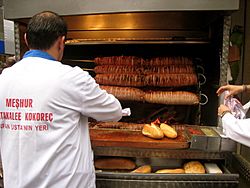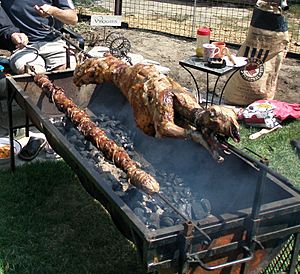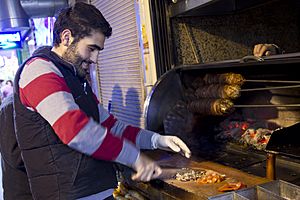Kokoretsi facts for kids

Multiple rolls of kokoretsi roasting on wood fire in İzmir, Turkey
|
|
| Type | Meat dish |
|---|---|
| Place of origin | Byzantine Empire |
| Region or state | Balkans, Asia Minor |
| Main ingredients | Lamb or goat intestines, offal (sweetbreads, hearts, lungs or kidneys) |
Kokoretsi or kokoreç is a special dish popular in the Balkans and Asia Minor. It's made from the intestines of lambs or goats. These intestines are wrapped around seasoned offal, which includes parts like sweetbreads, hearts, lungs, or kidneys. This tasty roll is usually grilled. Sometimes, the inner parts are chopped and cooked on a flat grill instead. Young lamb intestines are often preferred for the best flavor.
Contents
What's in a Name?
Ancient Roots of Kokoretsi
A dish very much like today's kokoretsi was first known in the Byzantine Empire. People in the Byzantine Empire called it plektín, koilióchorda, or chordókoila. These names described the wrapped intestines. Some of these old names are still used in parts of Greece today. For example, in Corfu, it's called tsoilíchourda.
Another old name from medieval times was gardoúmion. From this, we get the Greek words gardoumpa and gardoumpákia. These names are used for a smaller version of kokoretsi in Greece. The word gardoúmion comes from the Latin word caldumen, which means 'warm' or 'hot'.
Where the Word "Kokoretsi" Comes From
The Greek word kokorétsi might come from the Albanian word kukurec. However, some experts believe both words came from Slavic languages. In those languages, kukuruza originally meant 'corncob'.
The Turkish word kokoreç was first written down in 1920. A Turkish writer named Ömer Seyfettin heard about it from a cook in Istanbul. The cook said it was a Greek dish made from small lamb intestines. The Turkish word kokoreç comes from the Greek word kokorétsi.
How is Kokoretsi Made?
Preparing the Meat
First, the inner meats (offal) and some fat are carefully washed. Then, they are cut into pieces about ½ to ¾-inch thick. These pieces are lightly seasoned with lemon juice, olive oil, oregano, salt, and pepper. Sometimes, a little garlic is added too.
The intestine itself is turned inside out and washed very well. After washing, it's rubbed with salt. Often, it's soaked in vinegar or lemon juice mixed with water to make sure it's super clean.
Putting it Together
Next, the seasoned meat pieces are threaded onto a long skewer. Then, the cleaned intestine is carefully wrapped around the meat. This creates a tight roll. These rolls are usually about 16 to 24 inches long and 1½ to 3 inches wide.
Cooking Methods
Kokoretsi is usually cooked on a spinning skewer. This skewer turns slowly over hot charcoal, gas, or an electric burner. While it cooks, it might be brushed with lemon juice and olive oil to keep it moist and flavorful.
There's also a different way to make it. The chopped inner meats are mixed with chopped tomatoes and green peppers. This mixture is then cooked on a large, hot griddle. Hot red pepper and oregano are added for extra flavor. The cook constantly mixes and chops the food with two spatulas. Once it's ready, the dish is kept warm on the griddle until someone orders it.
How to Enjoy Kokoretsi
Serving Styles
When kokoretsi is cooked, it's usually chopped or sliced into smaller pieces. Then, it's sprinkled with more oregano and served on a plate. Sometimes, it's served on a piece of flatbread. Some people like to add tomatoes or extra spices to their serving.
In Turkey, kokoretsi is often served in half a baguette or a sandwich bun. It can be plain or with toppings, but it almost always has oregano and red pepper. Common side dishes in Turkey are pickled peppers or cucumbers. It's often seasoned with lemon, oregano, salt, and pepper. People often enjoy it with wine or rakı.
-
Sliced kokoretsi, served with flatbread and french fries in Ioannina
Kokoretsi Around the World
Byzantine Empire and Greece

The people of the Byzantine Empire prepared sheep and goat intestines in a similar way to how Greeks make kokoretsi today. They cleaned the intestines by turning them inside out with a stick. Then, they wrapped them around other inner parts on a skewer.
Today, in Greece, kokoretsi is a traditional dish for Orthodox Easter celebrations. It's often eaten as an appetizer while the main lamb dish is roasting. However, you can find it served all year round too. A smaller version of kokoretsi is called gardouba or gardoumpákia. It can be grilled, roasted in a pan, or cooked in the oven.
In the late 1990s, there were some health discussions about eating offal. But the idea of banning kokoretsi was eventually dropped.
Turkey
Kokoretsi is a very popular fast food in Turkey. Many people see it as a special treat there. While some restaurants serve it, most kokoretsi is made and sold at small stands or kiosks all year. It's often eaten as a sandwich. People who make and sell kokoretsi in Turkey are called kokoreççi.
In the early 2000s, when Turkey was discussing joining the European Union, some Turkish media worried that EU food rules might lead to a ban on kokoretsi. However, this did not happen.
See also
 In Spanish: Kokoreç para niños
In Spanish: Kokoreç para niños




